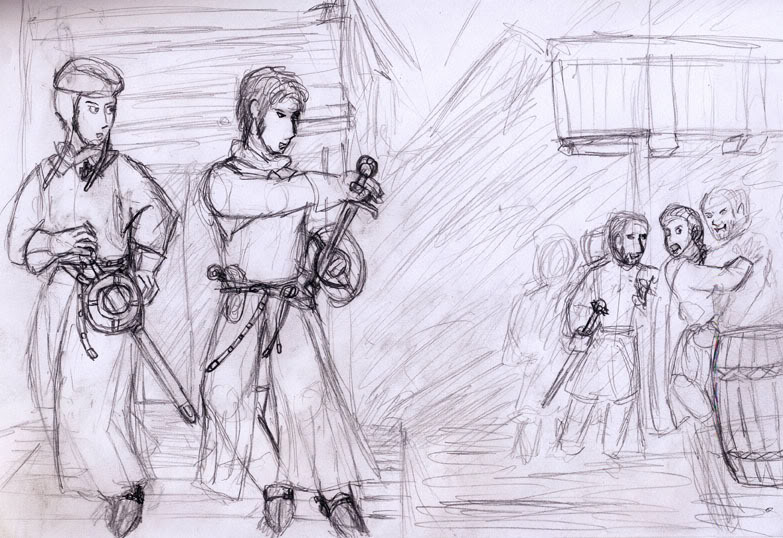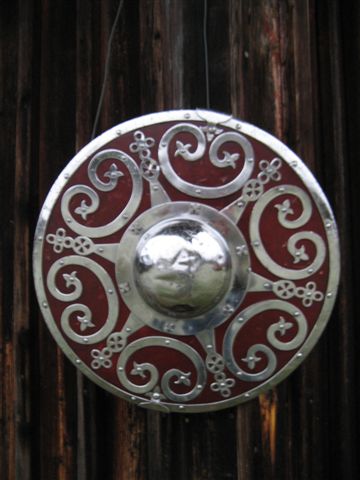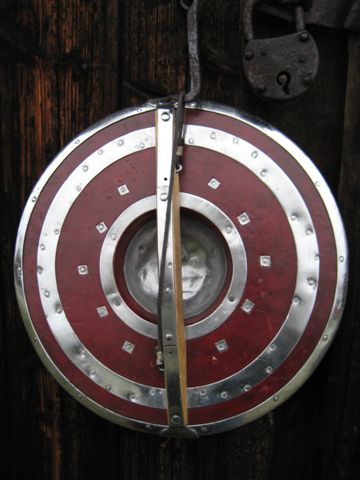Posts: 870 Location: Paris, France
Tue 24 Jul, 2007 1:57 am
| Greg Coffman wrote: |
| You are either punching with the boss or punching with the edge and neither vary enough by size if the buckler is that round classic shape. F=MA. If you double the mass then you double the force. So a heavier buckler hits harder than a lighter one, all other things constant. But if you keep it light so you can punch twice as fast then you quadruple the force. This isn't perfect but I mean to show that a smaller buckler works just fine. |
Actually what you say is the interpretation of another fundamental equation from mechanics, E = 0.5 M V*V, E being kinetic energy, M the mass and V the speed. So indeed if you double the speed, you quadruple the energy, and that is this energy that will cause damage.
Interestingly, putting the energy into the weapon is also what consumes your own energy, so that over a fairly wide range of masses, E will be constant (because there is only so much energy one can give), and V will vary accordingly, making the heavier buckler slower and the lighter buckler quicker. You will also need a greater length of motion to transfer the energy into the buckler when it is heavier.
If the buckler becomes too light, you run into another limit of human body, the speed at wich you can move your arm, so the energy diminishes. But I don't think this happens with bucklers given the weight of even a single boss...
How much damage is done depends on the surface of the contact (which as you rightly point out, does not change much with smaller bucklers), and the relative masses of the buckler and target. A lighter buckler will inflict greater damage to lighter targets. The advantage of the heavier buckler is that it will not only damage the target but also put it in motion, which is a great way to unsettle the opponent...
Sorry for the nitpicking ;)
Posts: 38 Location: Devon,England
Tue 24 Jul, 2007 5:06 pm
Thanks for the scientific info Vincent.
Some further thoughts on the issue. I think recycling was extremely important. As has often come out in threads, materials and metal were dear, labour was cheap.
Yes small bucklers would be easy to carry but I reckon a boss with a handle would be awkward. The London museum ones that Merv has shown us are both 10 inches plus. 8 or 10 inches would and does hang quite nicely, but a boss with a handle is a lump that rolls around - like hanging a beer mug on your belt - better in your hand !!!!!!!!!
I just feel new or recycled boss, most people would want a bit of material around it and end up with something like the ones pictured.
Richard
Posts: 254 Location: Lubbock, TX
Tue 24 Jul, 2007 6:57 pm
i understand that my math was rough ;) , but I still think F=MA works. Acceleration is the velocity the buckler is traveling at the point of impact over the amount of time it takes for it to come to rest after that impact. At least, this is the way I think of it. But I appreciate and gain much from your perspective as well.
And what I meant by all of this is that a smaller buckler does not have and advantage as far as power in the punch. Now, if it moves quicker then that is an advantage. You want to be able to get the buckler placed where you want it quickly, whether you are punching or deflecting or binding or whatever. It is also a plus that it doesn't tire your arm out as fast. Of course perhaps I should just "grow stronger." Really, once you learn to intercept the opponents blade accurately with the smaller buckler, it sort of evens out and doesn't seem so small.
Posts: 870 Location: Paris, France
Wed 25 Jul, 2007 2:08 am
| Greg Coffman wrote: |
| i understand that my math was rough ;) , but I still think F=MA works. Acceleration is the velocity the buckler is traveling at the point of impact over the amount of time it takes for it to come to rest after that impact. At least, this is the way I think of it. But I appreciate and gain much from your perspective as well. |
Oh sure, F=MA is true. I was specifcally reacting to the point you were making about quadrupling the "force" of impact, which I feel is better explained by energetic considerations. If I understand correctly what you say, you consider that F = M A = M V / dt, with dt the duration of the impact, then assume that dt is simply linked the speed of impact V like that: dt = k / V, which leads to F = M V V / k. Which leads to the quadrupling...
The problem with this approach is that it makes assumptions about the impact that are hard to verify:
1) force is constant during impact
2) damage is proportionnal to force
3) duration of the impact is simply linked to the speed of the object
1) and 3) are likely wrong in real life. 2) is probably not so easy to justify either. All these are hard to observe because the timing of the impact is so short.
So the usual approach used in impact studies is to consider the situation before impact, the situation after impact, and what is conserved between these, to infer what happens during the impact. I'd gladly do the demonstration here, but since it has already been done elsewhere on the web I'll be able to shorten my post ;) : http://hyperphysics.phy-astr.gsu.edu/hbase/inecol.html (I'm linking to inelastic collisions because they are the most damaging for the target, but the elastic case is interesting as well)
But enough off-topic math :D
I completely agree with what you said about the advantages of a quicker buckler. Dynamic defence becomes gradually more important with smaller shields, because it becomes impossible to just "hide behind"... I'll try to keep that in mind since I'm planning on making myself a buckler as well, and I'm still unsure of the size it will have.
Another possible advantage of a small buckler is that it would not hinder movement of your sword and sword arm as much, when using it close to the sword hand as seems to be the case in I.33. Maybe it facilitates some cuts or transitions?
Regards
Posts: 4
Sun 29 Jul, 2007 2:00 pm
Another advantage of the small buckler is that it can be used to grapple. Step inside a blow, and hook it up under your opponent's arm-pit and pull, there's nothing that they can do about that, and if your sword is short enough, or you drop it and pull a dagger it's game over for them.
I have fought with a 10" buckler and a 7" one, and find that I fight better with the 7"
Daniel
Posts: 1,576 Location: Bergen, Norway
Tue 31 Jul, 2007 1:46 pm
The best way to carry the buckler is by means of a leather strap that is paralel to the handle.
This is passed over the top of the scabbard, before the sword is inserted.
Thus, the sword and buckler can be drawn at the same time. The same can be done with a simple loop around the handle, but this means there is a risk of the buckler bouncing around and twining itself up.
The preserved norwegian bucklers have this kind of suspension.
Posts: 1,576 Location: Bergen, Norway
Wed 01 Aug, 2007 7:49 am
A quick sketch showing how and why to carry your buckler for the quick draw :)

Posts: 8,310 Location: Montreal,Quebec,Canada
Wed 01 Aug, 2007 8:07 am
| Elling Polden wrote: |
A quick sketch showing how and why to carry your buckler for the quick draw :)
|
Makes a lot of practical sense and shows that sometimes it's the little things that make the difference for easy usage.
I wonder how much documentation shows or talks about this ? Might be a case of something being so well known and obvious in period that nobody would even bother mentioning in in an instruction text on the use of the buckler or in anything else really.
Glad to know as I can now make the necessary leather loop for my buckler. :cool:
Posts: 217
Wed 01 Aug, 2007 12:51 pm
maybe impulse (=mv) or inertia will add to the quotation as well. Since the human muscles can only generate a certain speed before needing to cheat, if you wish to have enough impulse to change the course of something heavy, you will have to use something heavy to change it with (there is a reason a baseball bat, whose purpose is to change the direction of a baseball, is not made out of a tube, even if vibrations are not counted). As you may have noticed, impulse looks like energy divided by speed, so the total amount of energy needed to generate more impulse drops with an increase in mass.
just my € 0,02
Posts: 38 Location: Devon,England
Wed 01 Aug, 2007 2:47 pm
Elling,
I was too sure about your post and how the buckler fitted over the scabbard, But your sketch is brilliant.
All is clear now.
I think Jean is right - its probably the sort of thing that is so simple and common , no one thought to write it down !
Thanks
Richard
Posts: 336
Wed 01 Aug, 2007 8:02 pm
Thanks for the sketch Elling. ;)
Have you tried to use this kind of suspension for "real" ?
Posts: 61 Location: Drammen, Norway
Thu 02 Aug, 2007 3:24 am
Posts: 64 Location: Denmark/ Fredericia
Thu 02 Aug, 2007 3:49 am
Nice buckler Niels !
What are the size on this buckler ?
Venlig hilsen
Klaus
Posts: 61 Location: Drammen, Norway
Thu 02 Aug, 2007 11:37 am
Its 35,5 cm in diameter, about the same size as the last two bucklers that Merv Cannon posted in his post. Those are kept in the National Museum in Copenhagen, but are probably produced in Norway.
So, the buckler are not what you would call small... but they are nice anyway :)
Another reproduction and some pictures of the the four bucklers form Norway can be foud here:
http://forums.armourarchive.org/phpBB2/viewto...highlight=
N.
You
cannot post new topics in this forum
You
cannot reply to topics in this forum
You
cannot edit your posts in this forum
You
cannot delete your posts in this forum
You
cannot vote in polls in this forum
You
cannot attach files in this forum
You
can download files in this forum


